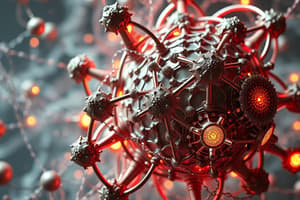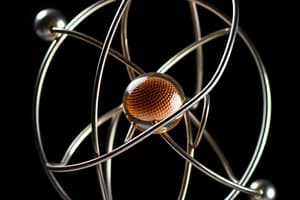Podcast
Questions and Answers
What are the three primary constituents of an atom?
What are the three primary constituents of an atom?
Protons, neutrons, electrons
Where do protons and neutrons reside in an atom?
Where do protons and neutrons reside in an atom?
In the nucleus
How do electrons move in relation to the nucleus of an atom?
How do electrons move in relation to the nucleus of an atom?
Orbit like satellites
What is the nucleus of an atom composed of?
What is the nucleus of an atom composed of?
What offsets the electrostatic repulsion between protons in the nucleus of an atom?
What offsets the electrostatic repulsion between protons in the nucleus of an atom?
How are heavier atoms with distinct characteristics created from the foundation of hydrogen atoms?
How are heavier atoms with distinct characteristics created from the foundation of hydrogen atoms?
Explain the concept of electron shells in an atom.
Explain the concept of electron shells in an atom.
What is the Pauli Exclusion Principle and how does it relate to electron occupancy in shells?
What is the Pauli Exclusion Principle and how does it relate to electron occupancy in shells?
How does the periodic table help in understanding the arrangement of electrons in atoms?
How does the periodic table help in understanding the arrangement of electrons in atoms?
Explain the terms 'ionization energy' and 'electron affinity' in the context of atomic structure.
Explain the terms 'ionization energy' and 'electron affinity' in the context of atomic structure.
How do ionization energy and electron affinity influence the reactivity and bond formation of chemical species?
How do ionization energy and electron affinity influence the reactivity and bond formation of chemical species?
Why is the understanding of atomic structure fundamental to gaining insights into chemistry as a whole?
Why is the understanding of atomic structure fundamental to gaining insights into chemistry as a whole?
Flashcards are hidden until you start studying
Study Notes
Unraveling Matter's Building Blocks: Understanding Atomic Structure in Chemistry
Every object around us is made of tiny particles called atoms, each with their own unique chemical properties. To comprehend how these building blocks interact, we must first delve into the intricate world of atomic structure — a fundamental concept in chemistry. In this exploration, we'll unpack the essential components of atom architecture while keeping our focus on clarity and simplicity.
Fundamental Components
Atoms consist of three primary constituents: protons, neutrons, and electrons. Protons and neutrons dwell within the dense nucleus at the heart of every atom, whereas electrons orbit the nucleus like satellites. We can decompose all matter into hydrogen atoms (consisting solely of one proton) when we look closely enough. All other elements derive from variants of this foundation by adding either neutrons or additional protons to create heavier atoms with distinct characteristics.
Nuclear Model
The nucleus — often depicted as an orange ball with black dots inside it—contains the vast majority of an atom’s mass. It's composed almost entirely of two types of neutral particles: positively charged protons and normally neutral neutrons. These particles attract each other via nuclear forces, offsetting electrostatic repulsion between the positive charges. Lithium, for instance, has three protons and four neutrons in its nucleus.
Electron Shells
Contrary to popular belief, atoms aren't hollow like bowling balls; they have a cloudlike distribution of negatively charged electrons surrounding the positively charged nucleus. Electrons exist in discrete energy levels known as shells or orbitals arranged in successive layers based upon their distance from the nucleus. Each electron occupies only one space per shell, following Pauli Exclusion Principle rules which state maximum two electrons can occupy any given orbital, and those electrons must possess opposite spins.
Periodic Table & Element Properties
By arranging elements according to increasing atomic number, chemists created the periodic table, which exhibits recurring patterns among similar element properties. This organization also provides insight into the arrangement of electrons in various atoms. For instance, hydrogen boasts just one electron in its single, primary shell, whereas oxygen features eight electrons distributed across two shells.
Ionization Energy & Electron Affinity
Ionization energy represents the amount of energy required to remove the outermost electron(s) from an isolated gaseous atom, resulting in a positively charged ion. Conversely, electron affinity refers to the release of energy occurring when an extra electron binds to a previously neutral gaseous atom, forming a negative ion. These attributes play crucial roles in determining reactivity and bond formation propensity among chemical species.
As you absorb and reflect upon the fundamentals of atomic structure, your understanding of chemistry will deepen and broaden, offering insights into complex interactions among elementary particles. By learning more, you embark upon a journey of discovery through the intriguing realm of molecules, compounds, reactions, and even life itself!
Studying That Suits You
Use AI to generate personalized quizzes and flashcards to suit your learning preferences.




